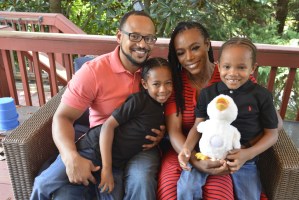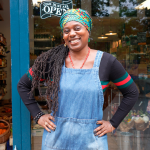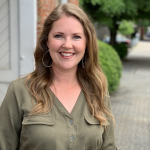

Sean, Saxton, Shea and Sawyer (Courtesy Photo)
By Alexis Taylor
Special to the AFRO
Shea Guillory was shocked when the Sickle Cell Foundation of Georgia began sending letters one week after she took her newborn home.
Yes, she had asked the pediatrician to test for sickle cell disorders prior to leaving the hospital. Yes, she was aware that she had the sickle cell trait. But how could her son, Sawyer, actually have sickle cell disease (SCD)?
“I was in denial at first. I told her to test him again. It can’t be- it’s just the trait,” said Guillory, hoping her son would avoid the more serious complications of SCD. “I gave myself time before the next visit to get angry, cry and be upset. Then I got myself together.”
Luckily, Guillory’s pediatrician was a former hematology specialist- well versed in blood disorders. Further testing confirmed that Guillory’s son had SCD.
The term is used for a group of conditions known to cause malformed red blood cells, which are crucial in carrying oxygen throughout the body.
According to the Centers for Disease Control and Prevention (CDC), when SCD is present “the red blood cells become hard and sticky and look like a C-shaped farm tool called a ‘sickle.’”The sickle-shaped cells die prematurely, causing the body to continuously lack the appropriate number of red blood cells.
When these sickle cells “travel through small blood vessels, they get stuck and clog the blood flow,” according to the CDC. “This can cause pain and other serious problems such infection, acute chest syndrome and stroke.”
The American Society of Hematology reports that between 70,000 and 100,000 Americans battle SCD, and one in 12 African Americans have the trait.
The disorder is diagnosed by a blood test. Sickle cell diseases vary based on whether two sickle cell genes or a combination of sickle cell and abnormal hemoglobin genes are inherited. People with the sickle cell trait have one normal gene and one sickle cell gene, and typically avoid more serious symptoms of SCD.
Partners can make an informed decision when it comes to procreating by asking about family history.
“My husband and I kind of discussed the fact that I had sickle cell trait,” said Guillory. “I asked him when we were dating if anybody in his family had sickle cell or carried the trait. He wasn’t 100 percent sure, but we never circled back to that. We just went on dating. Years later we ended up getting married and having children and then came the letters.”
Ultimately, Sawyer’s SCD would require a bone marrow transplant.
“I did a lot of research and that’s when I came across Be the Match. There’s a lack of African Americans and people of color on that list and we want to get people to sign up.”
As fate would have it, the donor that Sawyer needed had arrived Earthside with him. His twin was his donor.
“If my three-year-old son at the time could have enough courage to give his bone marrow to his brother, hopefully that will give other people the initiative to be able to stand up and do the same for others if they can,” said Guillory. “We want to kill any negative information or fear that people may have about becoming transplant donors.”
Sawyer had his brother by his side, but he also had another friend to help process the medical challenges of SCD. As part of their initiative to help children fighting cancer, Aflac dispersed 12,000 interactive toy robots.
Sawyer received the “My Special Aflac Duck” after the company piloted a special duck for children fighting SCD.
“We learned that when some children with SCD go from extreme heat- like we have here in Georgia- into their air conditioned homes, that could trigger a pain crisis,” said Buffy Swinehart, Aflac’s senior manager of corporate responsibility. “One of the things we added to My Special Aflac Duck for sickle cell patients is a blanket that children will actually be able to design and wrap around their duck.”
The company aims to help children with SCD express emotions by using the duck’s emotion cards and an app has been created with the toy to help children acclimate to prescription routines.
To improve access to SCD information in the Black community, Aflac has teamed up with Ebony Magazine for a webinar on Sept. 30th at 8 p.m.
The Guillory family has been tapped to spread awareness and inspire others on a national level. They have also started their own nonprofit called Sawyer’s Sickle Circle.
“I created Sawyer’s Sickle Circle to help spread awareness and to encourage people who are not tested to get tested,” said Guillory. “We need to start talking about this in our communities. We can’t expect individuals from other nationalities and the government to talk about it if we’re not talking about it.”
To register for the Ebony/ Aflac webinar on sickle cell visit https://www.eventbrite.com/e/ebony-community-connect-sickle-cell-awareness-discussion-tickets-169407836399
Help us Continue to tell OUR Story and join the AFRO family as a member – subscribers are now members! Join here!
The post Sickle Cell awareness and education crucial for Black families in 2021 appeared first on AFRO American Newspapers .











